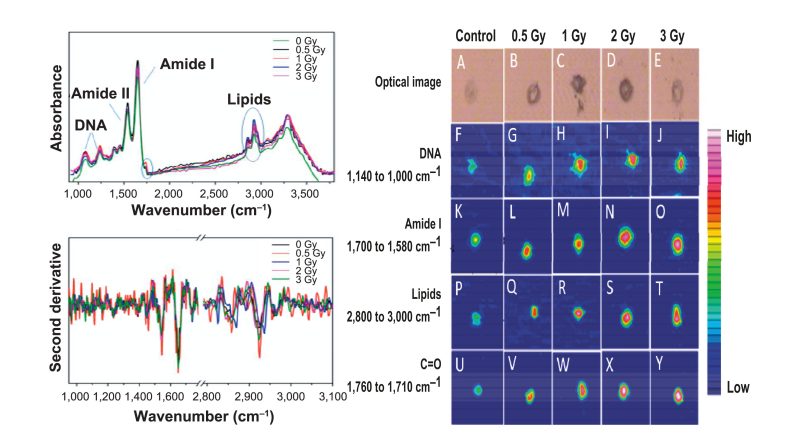Nowadays, Fourier transform infrared (FTIR) spectroscopy has attracted increasing attention in biological studies due to its advantages including simple, fast, label-free, nondestructive detecting features.
In addition to its advantages in biological study, it can be also used to qualitatively and quantitatively examine the structures and contents of proteins, lipids and nucleic acid in various biological samples. Notably, infrared spectroscopy combined with optical microscopy, so-called infrared micro-spectroscopy, could be utilized to monitor the cellular status and process in situ alive.
Thus, FTIR micro-spectroscopy has emerged as a new powerful tool for cell research.
In a recent study by Prof. HUANG Qing’s study team of Institute of Technical Biology & Agriculture Engineering, Hefei Institutes of Physical Science bio-spectroscopy is applied to the study of radiation effect on cancer cells. Their research was publish in Radiation Research.
In their work, infrared microspectroscopy was used to detect the metabolic changes related to p53 under particle radiation. p53 is a crucial tumor suppressor and plays an important role in cell cycle arrest, DNA damage repair, cell senescence and apoptosis.
However, the p53-related early cellular processes involved in radiation effects and the corresponding mechanisms are largely elusive. The reason for the cellular processes are difficult to elucidate is due to lack of effective nondestructive tools to monitor the radiation induced metabolic and chemical changes in cells.
HUANG's group used alpha-particles to irradiate HCT116 cells (p53+/+, p53–/–), and observed remarkable spectral differences between the two genotypes of cells. Based on the FTIR spectral analysis, they found less radiation effect on the mut cells (p53–/–) than on the wt cells (p53+/+) in terms of biomolecular changes such as lipid peroxidation, indicating higher radiation resistance persisting in the p53-knockout cells.
As for the significance of this research, this work not only shows that FTIR micro-spectroscopy and imaging can effectively reveal the p53-related radiation effects with the biochemical and metabolic changes of the cells under particle irradiation, but also demonstrates the new way of application of infrared spectroscopy in the field of radiation research.
This work was supported by the National Nature Science Foundation of China.
Link to the paper: FTIR Microspectroscopy Probes Particle-Radiation Effect on HCT116 cells (p53+/+, p53-/-)

FTIR spectra and chemical images for HCT116 cells (Image by YAN Jingwen)
Contact:
ZHOU Shu
Hefei Institutes of Physical Science (http://english.hf.cas.cn/)
Email: zhous@hfcas.ac.cn
 Tel: +86-551-65591206
Tel: +86-551-65591206
 Fax: +86-551-65591270
Fax: +86-551-65591270
 Emai: zhous@hfcas.ac.cn
Emai: zhous@hfcas.ac.cn
 350 Shushanhu Road
350 Shushanhu Road